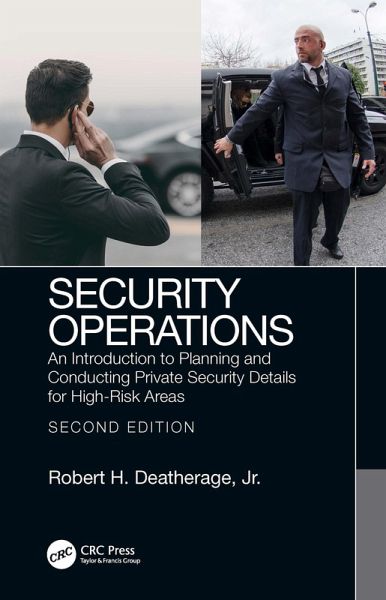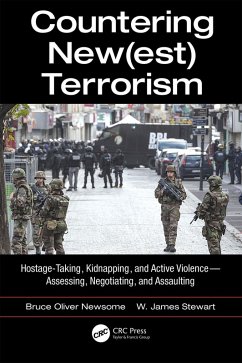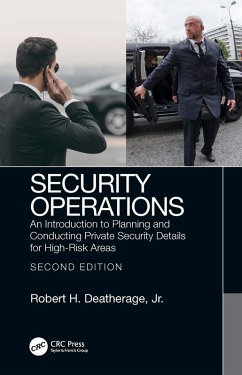
Security Operations (eBook, PDF)
An Introduction to Planning and Conducting Private Security Details for High-Risk Areas
Versandkostenfrei!
Sofort per Download lieferbar
66,95 €
inkl. MwSt.
Weitere Ausgaben:

PAYBACK Punkte
33 °P sammeln!
Security Operations: An Introduction to Planning and Conducting Private Security Details for High-Risk Areas, Second Edition was written for one primary purpose: to keep people alive by introducing them to private security detail tactics and techniques. The book provides an understanding of the basic concepts and rules that need to be followed in protective services, including what comprises good security practice. This second edition is fully updated to include new case scenarios, threat vectors, and new ambush ploys and attack tactics used by opportunistic predators and seasoned threat actor...
Security Operations: An Introduction to Planning and Conducting Private Security Details for High-Risk Areas, Second Edition was written for one primary purpose: to keep people alive by introducing them to private security detail tactics and techniques. The book provides an understanding of the basic concepts and rules that need to be followed in protective services, including what comprises good security practice. This second edition is fully updated to include new case scenarios, threat vectors, and new ambush ploys and attack tactics used by opportunistic predators and seasoned threat actors with ever-advanced, sophisticated schemes.
Security has always been a necessity for conducting business operations in both low- and high-risk situations, regardless of the threat level in the operating environment. Overseas, those with new ideas or businesses can frequently be targets for both political and criminal threat agents intent on doing harm. Even in the United States, people become targets because of positions held, publicity, politics, economics, or other issues that cause unwanted attention to a person, their family, or business operations.
Security Operations, Second Edition provides an introduction to what duties a security detail should perform and how to effectively carry out those duties. The book can be used by a person traveling with a single bodyguard or someone being moved by a full security detail.
FEATURES
. Identifies what can pose a threat, how to recognize threats, and where threats are most likely to be encountered
. Presents individuals and companies with the security and preparedness tools to protect themselves when operating in various environments, especially in high-risk regions
. Provides an understanding of operational security when in transit: to vary route selection and keep destinations and movement plans out of the public view
. Outlines the tools and techniques needed for people to become security conscious and situationally aware for their own safety and the safety of those close to them
An equal help to those just entering the protection business or people and companies that are considering hiring a security detail, Security Operations is a thorough, detailed, and responsible approach to this serious and often high-risk field.
Robert H. Deatherage Jr. is a veteran Special Forces Soldier and private security consultant with thirty years' experience in military and private security operations. His various writings on security topics cover security operations, threat assessment, risk management, client relations, surveillance detection, counter surveillance operations, foot and vehicle movements, and building security-blending solid operational theory with practical field experience.
Security has always been a necessity for conducting business operations in both low- and high-risk situations, regardless of the threat level in the operating environment. Overseas, those with new ideas or businesses can frequently be targets for both political and criminal threat agents intent on doing harm. Even in the United States, people become targets because of positions held, publicity, politics, economics, or other issues that cause unwanted attention to a person, their family, or business operations.
Security Operations, Second Edition provides an introduction to what duties a security detail should perform and how to effectively carry out those duties. The book can be used by a person traveling with a single bodyguard or someone being moved by a full security detail.
FEATURES
. Identifies what can pose a threat, how to recognize threats, and where threats are most likely to be encountered
. Presents individuals and companies with the security and preparedness tools to protect themselves when operating in various environments, especially in high-risk regions
. Provides an understanding of operational security when in transit: to vary route selection and keep destinations and movement plans out of the public view
. Outlines the tools and techniques needed for people to become security conscious and situationally aware for their own safety and the safety of those close to them
An equal help to those just entering the protection business or people and companies that are considering hiring a security detail, Security Operations is a thorough, detailed, and responsible approach to this serious and often high-risk field.
Robert H. Deatherage Jr. is a veteran Special Forces Soldier and private security consultant with thirty years' experience in military and private security operations. His various writings on security topics cover security operations, threat assessment, risk management, client relations, surveillance detection, counter surveillance operations, foot and vehicle movements, and building security-blending solid operational theory with practical field experience.
Dieser Download kann aus rechtlichen Gründen nur mit Rechnungsadresse in A, B, BG, CY, CZ, D, DK, EW, E, FIN, F, GR, HR, H, IRL, I, LT, L, LR, M, NL, PL, P, R, S, SLO, SK ausgeliefert werden.













